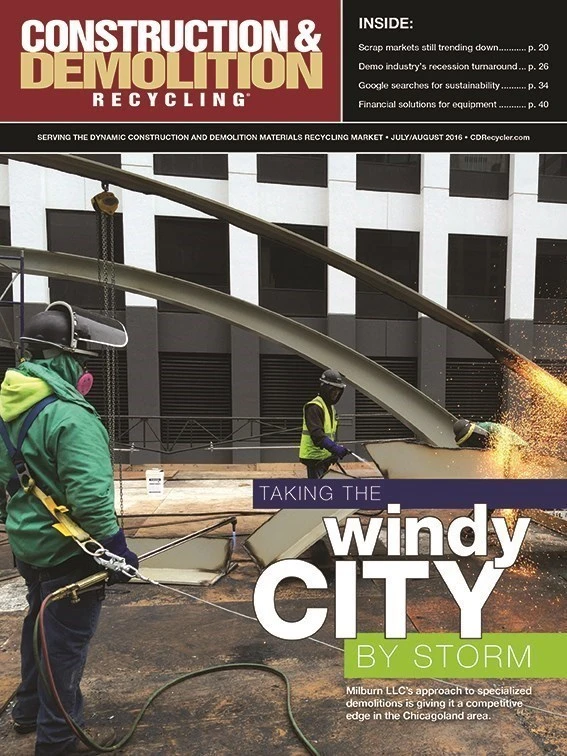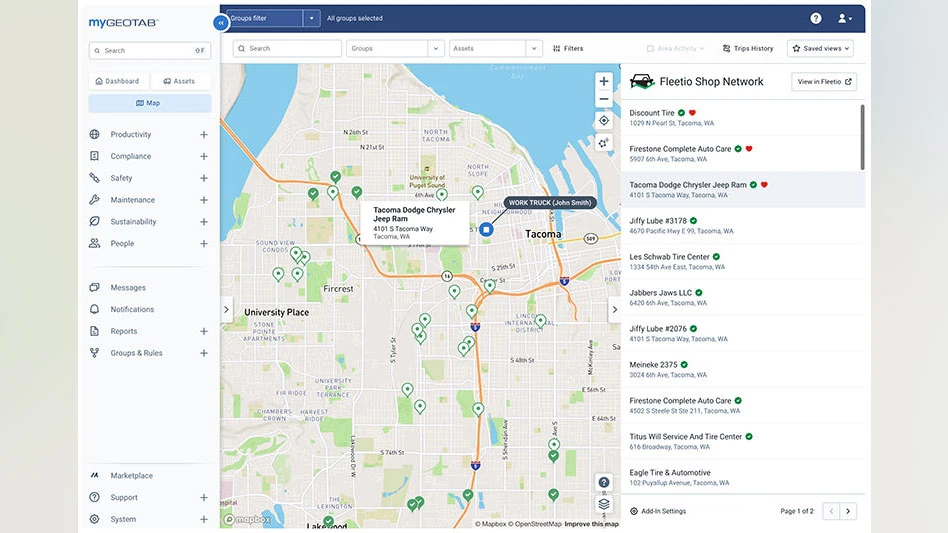
Demolition contractors and mixed C&D plant operators who gain part of their income from the iron and steel scrap they handle have had a tough time budgeting in late 2015 and the first half of 2016.
In the fall of 2015, after a period of relative stability in steel and ferrous scrap pricing, per ton prices in that market plummeted, with analysts blaming persistent overcapacity in Chinese steel production as the culprit.
Although China’s urbanization and infrastructure boom has slowed down, it’s steelmakers (many of them state-owned) have continued to churn out steel, flooding the global market and slowing down competing melt shops in the United States and many other nations.
MORE THAN NECESSARY
Demolition contractors and C&D recyclers in the U.S. who were confronted with lower scrap iron scale prices can look several thousand miles east for part of the reason, at least according to U.S. steel producers.
In a feature story appearing in the March 2016 issue of Recycling Today magazine, a sister publication, the American Iron and Steel Institute (AISI), Washington, pointed to excessive steel output in China as the cause of an oversupply situation that was bringing down global steel prices and putting a lid on production in the U.S. and other nations far from China.
“The imports came from countries that subsidize, or even fully control, their steel industries—leaving American steelmakers to compete against not just other companies but also against foreign governments,” wrote Thomas J. Gibson, president and CEO of AISI, and Chuck Schmitt, chairman of the AISI board of directors.
The situation in 2015 was worse, they say. “Capacity utilization shrank to as low as 60 percent in 2015, while steel imports captured a record high market share of 29 percent. This is unsustainable. At the same time, domestic steel production has continued to decline. Year-to-date shipments as of November 2015 stood at 80 million net tons—11.4 percent less than the 90.3 million net tons U.S. steel mills shipped during the same 11 months in 2014.”
The AISI president and chairman say that despite the U.S. economy being reasonably healthy in late 2015 and early 2016, steel producers and ferrous scrap suppliers did not enjoy any of the benefits. “Nearly 12,000 jobs have been lost in just the past year alone. And nearly one out of every three tons of steel sold here in 2015 was produced outside the country.”
The situation served to push ferrous scrap prices down from $346 per ton (for shredded ferrous scrap) in January 2015 all the way down to $178 per ton in December of the same year—essentially a 50 percent drop in value. Throughout 2015 and 2016, China’s government has continued to pledge that it will cut its steel production. In January 2016, the State Council announced that “China will cut crude steel production capacity by 100 to 150 million tons.”
However, the State Council announcement did not specify a time frame for the cuts, and subsequently Chinese steel producers in the first half of 2016 have, in the aggregate, maintained output at nearly identical levels to those in 2015 and 2014, despite a significant drop-off in demand for steel within China.
Although China’s production of steel dropped by 2.3 percent in 2015 compared with 2014, the 804 million metric tons it produced in 2015 is still considered by most steel industry analysts to far outweigh the country’s domestic consumption. 2016 is shaping up to result in a similar disparity between Chinese steel output and domestic demand for finished steel.
“To make up for this falling demand at home, China has been shipping out ever greater quantities of steel at below-market prices. In December 2015, China exported a record 112 million metric tons, up nearly 20 percent from its 2014 record of 94 million metric tons, wrote Gibson and Schmitt.
A WELCOME RALLY
Demolition contractors who experienced disappointing scrap iron pricing at the end of 2015 and the first two months of 2016 finally started experiencing some relief in the spring of 2016.
The supply and demand situation certainly played a role in that low prices yielded so little ferrous scrap that U.S. steel mills eventually had to pay more per ton to obtain supplies.
However, ferrous scrap recyclers and traders who gathered in Berlin in late May for the Bureau of International Recycling (BIR) World Recycling Convention discussed additional reasons for the spring pricing rebound. China remained the center of attention.
William Schmiedel of Sims Metal Management, New York, said that on April 21, 2016, on the Shanghai Futures Exchange (SHFE), contracts for 220 million tons of steel rebar were traded on one day.
As has long been in the case on the nonferrous side of the scrap recycling business, Schmiedel commented that speculation may now be “something we will have to contend with” in the ferrous scrap sector.
Calling the spring price spike, which followed a multimonth slump, a rollercoaster is “an understatement” said Schmiedel.
The steel and scrap price slump, largely caused by exported low-priced Chinese billet shipped to scrap importers such as Turkey, eventually drove scrap prices into a range that caused supply shortages, he added.
The resulting ferrous scrap price increase in March, said Schmiedel, was an indication that when prices are below $200, “The basic [scrap] collection system of our industry breaks down.”
BIR Ferrous Division board member Tom Bird of United Kingdom-based Mettalis Recycling Ltd. pointed to temporary steel output cuts in Tianjin, China, as another reason for the spring price spike. Civic officials in that city asked steelmakers throughout Tianjin to idle their furnaces in the weeks leading up to a local flower festival held in April and May.
The resulting “reduction in billet for a while” helped mills in places like Turkey “turn back to scrap,” said Bird. Those mills are back online, however, and “market dynamics have changed again,” remarked Bird.
Economist Jason Schenker of Prestige Economics, Austin, said the economic indicators he looks at have convinced him that both China and the United States are in manufacturing recessions. In China’s case, the company’s lengthening string of weak monthly purchasing managers index figures points to “a worsening recession,” said Schenker.
In the United States, Schenker said the automotive sector is the only major manufacturing sector that currently has strong output. The construction sector, meanwhile, exhibits marginal activity and the energy sector is in a severe situation that includes considerable numbers of loans likely to go unpaid.
At the Berlin gathering of recyclers and traders, which started in late May and continued into early June, delegates expressed concerns that per-ton prices for ferrous scrap would plunge as the June buying period got underway.
Instead, pricing tracked by American Metal Market (AMM) during the U.S. buying period in the first 10 days of June found weakness in some grades and regions but stability in others.
Prompt grades, reflected in the AMM Midwest Index No. 1 busheling figure for June, remained in the $275 per ton range for the second straight month, although both shredded scrap and No. 1 heavy melting steel (HMS) fell from $19 to $26 per ton in the same region.
In June, buyers on the East Coast paid a remarkable 31 percent more for blended No. 1 and No. 2 HMS compared with buyers on the West Coast ($317 per ton compared with $219.)
As for the second half of 2016, with China’s economy still facing an uncertain future and an election year causing business decision makers in the U.S. to pause on some investments, it seems unlikely that prices will return to the lofty levels of earlier this decade.

Explore the July 2016 Issue
Check out more from this issue and find your next story to read.
Latest from Construction & Demolition Recycling
- Radius to be acquired by Toyota subsidiary
- Pacific Steel selects Danieli as EAF equipment supplier
- Viably, Turmec partner on Ohio installation
- EPA plans to revisit numerous environmental, climate regulations
- Connecticut recycling facility looking to accept C&D faces local pushback
- Fornnax wins Green Innovation of the Year award
- ABC: Construction backlog inches lower, staffing levels expected to grow
- Former detention center in Cleveland set for demolition





